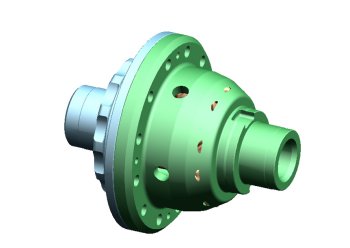|
The Alfa 147 on show at the Paris Motor
Show this month will represent the world premiere of the
self-locking front differential (known as the Q2) that
maintains and implements all the attributes of a front wheel
drive in terms of active safety and intuitive driving, while
increasing driving satisfaction and control. The innovative
system also guarantees some benefits typical of four wheel
drive but with decidedly lower weight and cost.
The Q2 system is based on the presence of a Torsen
mechanical limited slip differential. This differential
performs the specific task of distributing torque over the
front wheels in a dynamic, continuous manner according to
driving and road surface conditions. When combined with the
exclusive front double wishbone suspension, the system
allows particularly effective tuning of the car. The Alfa
Romeo engineers were fortunate because front wheel drive
already enjoys an excellent reputation among their customers
(it is no mere chance that this alternative is chosen by
most car manufacturers). Suffice it to say that over and
above the general benefits of this type of structure
(weight, passenger room etc.), the understeering behaviour
of a front wheel drive engine allows the driver to respond
to vehicle stress more intuitively under limit conditions:
hence the feeling that front wheel drive is ‘more sincere’
than rear wheel drive.
A significant increase in driving safety, in other words.
Opponents argue that front wheel drive can impair full
driving satisfaction and control under certain conditions,
giving rise to traction problems on corners, performance at
the limit of understeer or steering reactions because the
steering wheels are also the drive wheels. Alfa Romeo has
overcome this disadvantage by developing the Q2 system that
offers all the attributes of a front wheel drive system with
significantly increased roadholding, traction and stability
during over-run. At the same time, it lessens understeer
during acceleration, the action of electronic controls and
steering wheel vibrations. The following two practical
examples highlight the technical potentials of the Q 2
system.
|
 |
|
|
 |
|
|
|
 |
|
|
|
Example one: vehicle cornering
When cornering in
conditions of poor grip (e.g. wet, snowy or muddy road) or
during sporty driving, the inside wheels often lose grip due
to the fact that the differential distributes torque to the
wheel with the least load and takes torque away from the
outside wheel that could be subject to higher friction since
it has to bear the additional weight exerted by vehicle
roll. This situation may determine two different responses,
according to the equipment on the car. On a model without
ASR – VDC, the perceived result is slipping of the inside
wheel, loss of vehicle control (strong understeer) and lack
of acceleration when coming out of the bend. If the vehicle
is equipped with ASR – VDC, the steering assistance systems
cut in to take power from the engine by adjusting the
throttle. This makes it impossible to modulate the
accelerator and gives the driver the unpleasant sensation of
a loss of power and interaction with the vehicle. The result
in both cases is a feeling of being at a standstill on
leaving the corner.
What happens if the Q2 system is present: As the inside
wheel begins to lose grip, torque is partly transferred to
the outside wheel to ensure less understeer, greater
stability, higher exit speed from the corner and fewer and
less invasive vehicle control system operations. The net
result is an increase in driving satisfaction and full
control of the vehicle.
Second example: ground with
poor grip.
When driving over ground with poor grip, the traction of the
drive wheels is often different. For example, when driving
after a snowfall or heavy rain, one wheel is on the edge of
the carriageway in direct contact with lying snow while the
other is in a clean, dry area. In these particular
conditions, when the car sets off or accelerates strongly,
the wheel subjected to critical friction conditions will
slip with strong reactions on the steering wheel,
unsatisfactory take-off and the need to make continual
corrections to the steering wheel to maintain the
trajectory.
What happens if the Q2 system is present: The negative
effects are countered due to gradual transfer of torque
toward the wheel that is able to exploit the greatest
friction coefficient. This makes it easier, for example, to
perform a hill start on a mountain road and safer and more
comfortable to drive over road sections with poor surfaces.
The sophisticated Q2 system is yet another example of Alfa
Romeo excellence in the quest for technical solutions geared
for safety and driving satisfaction.
|
|
|
|